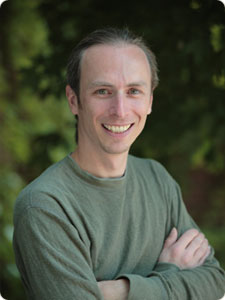In ‘Nature,’ Bowdoin Scientist Predicts Arctic Peatland’s Warming Impacts
By Rebecca Goldfine
Rusack Professor of Environmental Studies and Earth and Oceanographic Science Phil Camill
A team of scientists that includes Bowdoin professor Phil Camill has just released new findings on a question with significant implications for the future of the planet: how will the Earth’s peatlands, particularly the vast stretches in the Arctic, respond to global warming? Will they serve as carbon sinks or carbon sources?
The findings of Camill and his collaborators, published Sept. 10 in Nature Climate Change, point to a delicate balance—one that the research suggests will eventually tip in the wrong direction.
Currently peatlands store more carbon dioxide than any other terrestrial ecosystem in the world, providing a buffer against the most dramatic effects of climate change., providing a buffer against the most dramatic effects of climate change. Waterlogged and low on oxygen, peatlands slow the process of plant decomposition, so that layers of dead plants—which contain carbon from the atmosphere—accumulate over time.
The National Science Foundation has identified the fate of the Arctic as one of its top 10 “Big Ideas,“ to help guide its funding priorities. The agency says it wants to support research of the Arctic’s rapid biological, physical, chemical, and social changes and the environmental and economic impacts they are having on the broader Earth system.

The National Science Foundation has identified the fate of the Arctic as one of its top 10 “Big Ideas,“ to help guide its funding priorities. The agency says it wants to support research of the Arctic’s rapid biological, physical, chemical, and social changes and the environmental and economic impacts they are having on the broader Earth system.
Based on how peatlands in the past have responded to climate variations, the researchers are predicting that global peatlands will become greater carbon sinks through the next century, especially as the far north emerges from its deep freeze. Vegetation in the region will flourish in a carbon-rich environment and a longer, warmer growing season. This is a “greening effect,” and is encouraging for those worried about atmospheric carbon’s contribution to climate change.
However, at the same time, lower-latitude areas—more southern peatlands and boreal forests—will release increasing amounts of carbon in hotter, dryer conditions, contributing to a “browning effect.” As permafrost thaws, the peat soil decomposes and throws off the carbon it’s been harboring. The spruce and pine trees in the boreal biome, stressed for water, could become more susceptible to insect outbreaks and fires. Eventually this effect is likely to cancel out or overwhelm any benefits from the greening effect farther north.
“By the year 2100, these browning effects will become so widespread that they will overtake the greening of the Arctic,” Camill explained, even though the greening effect will likely continue beyond the end of the century. “This will have an overall effect of diminishing peatlands as a global carbon sink and may cause them to begin contributing to warming as decomposition outpaces plant growth.”
Now that Camill, with his partners, has published his findings about the climate change-mitigation limits of the Arctic peatlands, he is preparing for the next step of his research. He and four other collaborators have recently been awarded a five-year grant from the National Science Foundation to investigate the frontier of the Arctic’s greening belt.
“We’re telling the scientific story as it unfolds,” he said. “We know greening is happening, but how is it happening?”




Camill’s team is among the first to travel to the high-latitude tundra to study the creep northwards of the Arctic’s greening belt. Historically inhospitable to life, these frigid regions are mostly covered with barren rock, lichen, and sparse mosses.
But, “with climate warming, you can now make these Mars-like landscapes more vegetated—suitable, with enough moisture and warmth, for plants to start growing,” Camill said. He and his team want to figure out how and why the new peatlands are forming, and how much carbon they are sequestering from the atmosphere.
Over the past couple of decades, scientists and Arctic communities have observed “peat pockets exploding across the northern landscape,” Camill said. The patches are mostly formed from dead mosses, which are early landscape colonizers. By taking core samples of the pockets, the researchers can date the growth of the peat soils and determine how much carbon they have stored over the last few decades.
With data collected from sites in Baffin Island, Alaska, and western Canada, Camill and his partners will explain why and when the peatland pockets are forming where they do: “Is it warming? Are they showing up in low-lying depressions that are wet enough? Are there certain parts of the landscape where they show up?” Camill asks.
“By understanding these factors, we can make an assessment on how likely it is that this green wave will spread north,” he continued, and help predict how much human-produced atmospheric carbon the vegetated band will absorb going forward.
Though Camill is looking at just a “small chunk” of the big-scale changes happening in the Earth’s biogeochemical system, his work contributes to a larger effort by climate scientists and modelers to understand the relationship between the greening and browning effects, and to forecast when, and how powerfully, we will see changes from global warming.
“The overall net carbon balance is anyone’s guess at this point,” Camill said. “That is the ultimate question that lots and lots of scientists from around the world are going after.”
The grant Phil Camill received is funded through NSF’s MacroSystems Biology and Early NEON (National Ecological Observatory Network) Science programs, and is part of $9 million the agency is investing in nine research projects of “biosphere processes and their complex interactions with climate, land use and invasive species at regional and continental scales.”